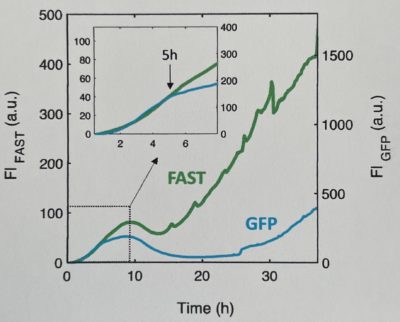Nelly Henry hast just disclosed FAST in multi-species low-oxygen biofilms to monitor their assembly over time. Exploration of multi-species biofilms is indeed one focus of her team at Sorbonne University. They furthermore collaborate with Institut Micalis of INRAE.
Multi-to microbial adherent communities are widespread in nature and organisms. But the principles of their assembly and development remain unclear. Here, the researchers have designed a dynamic model of multi-species biofilm from real-time monitoring of community development. The community comprises of Bacillus thuringiensis, Pseudomonas fluorescens, Kocuria varians, and Rhodocyclus sp. It deterministically reaches its equilibrium after ~30 h of growth. Fluorescence imaging indeed allowed to track increase in spatial heterogeneity, non-monotonic developmental kinetics, competition for resources. For this purpose, the researchers used GFP and FAST as reporters. FAST indeed offers the unique capability of working in oxygen-depleted conditions. The same team had already disclosed this unique feature in maturing E. coli biofilms in 2018. As a result, FAST allows quantitative reporting even in maturing biofilms where the distribution of oxygen is highly variable.
Finally, the model opens new avenues to the study of adherent bacterial communities in the context of rapid changes.
FAST in multi-species low-oxygen biofilms.
The Twinkle Factory supplies commercial fluorogens for FAST and splitFAST in a variety of colors ranging up to far-red with tfPoppy.
Stain different, tag FAST!
Read more about FAST in biofilms
npj Biofilms Microbiomes 2021 – Four species of bacteria deterministically assemble to form a stable biofilm in a millifluidic channel
Sci. Rep. 2018 – The inducible chemical-genetic fluorescent marker FAST outperforms classical fluorescent proteins in the quantitative reporting of bacterial biofilm dynamics

Recent Comments